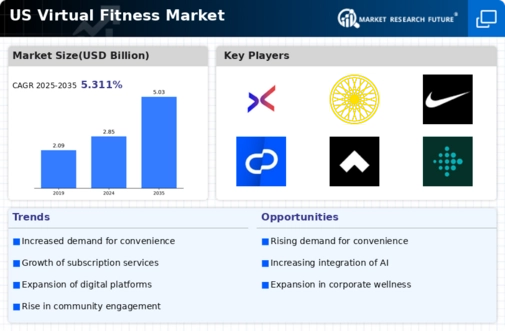Rise of Health Consciousness
The growing awareness of health and wellness among the US population is a significant driver for the virtual fitness market. Recent surveys indicate that approximately 70% of adults prioritize physical fitness as a key component of their overall health. This shift in mindset has led to an increased demand for accessible fitness solutions that can be integrated into daily routines. Virtual fitness platforms cater to this need by offering flexible workout schedules and diverse program options, making it easier for individuals to maintain their fitness goals. Furthermore, the emphasis on mental health and holistic well-being has prompted many to seek out virtual fitness solutions that combine physical activity with mindfulness practices. As a result, the virtual fitness market is likely to continue expanding, appealing to a broader audience seeking convenient and effective ways to enhance their health.
Increased Focus on Convenience
Convenience is a pivotal factor driving the virtual fitness market, as consumers increasingly seek solutions that fit seamlessly into their busy lifestyles. The ability to access workouts from home or on-the-go eliminates barriers associated with traditional gym memberships, such as travel time and scheduling conflicts. Recent data suggests that nearly 60% of fitness enthusiasts prefer virtual workouts due to their flexibility. This trend is particularly appealing to working professionals and parents, who often struggle to find time for exercise. As a result, virtual fitness platforms are continuously innovating to enhance user experience, offering features such as on-demand classes and personalized workout plans. The emphasis on convenience is likely to sustain the growth of the virtual fitness market, as it aligns with the evolving expectations of modern consumers who prioritize efficiency and accessibility.
Diverse Offerings and Niche Markets
The virtual fitness market is characterized by a growing diversity of offerings that cater to various demographics and fitness levels. Platforms are increasingly recognizing the importance of niche markets, such as senior fitness, prenatal workouts, and specialized training for athletes. This segmentation allows providers to tailor their services to meet specific needs, thereby attracting a wider audience. For instance, the demand for senior-friendly virtual fitness programs has surged, with an estimated 20% of the US population projected to be over 65 by 2030. Additionally, the rise of boutique fitness studios transitioning to virtual formats has created unique opportunities for specialized training. This diversification not only enhances user engagement but also contributes to the overall growth of the virtual fitness market, as it encourages participation from individuals who may have previously felt excluded from traditional fitness environments.
Integration of Nutrition and Fitness
The virtual fitness market is increasingly integrating nutrition, recognizing the importance of a holistic approach to health. Many platforms are now offering comprehensive programs that combine workout routines with personalized meal plans and nutritional guidance. This trend is driven by the understanding that exercise alone may not yield optimal results without proper nutrition. Recent studies indicate that individuals who engage in both fitness and nutrition programs are more likely to achieve their health goals. As a result, virtual fitness providers are collaborating with nutritionists and dietitians to create well-rounded offerings. This integration not only enhances user satisfaction but also positions the virtual fitness market as a comprehensive solution for health and wellness. The potential for cross-promotion between fitness and nutrition services may further drive growth, appealing to consumers seeking a more integrated approach to their fitness journeys.
Technological Advancements in Streaming
The virtual fitness market is experiencing a surge in technological advancements that enhance streaming capabilities. High-definition video quality and low-latency streaming are becoming standard, allowing users to engage in real-time workouts with minimal interruptions. This trend is supported by the increasing availability of high-speed internet, with over 90% of households in the US having access to broadband. As a result, fitness platforms are investing heavily in technology to provide seamless experiences. The integration of augmented reality (AR) and virtual reality (VR) is also gaining traction, offering immersive workout environments. These innovations not only attract new users but also retain existing customers, thereby driving growth in the virtual fitness market. The potential for interactive and engaging content is likely to redefine user expectations and experiences in the industry.

















Leave a Comment